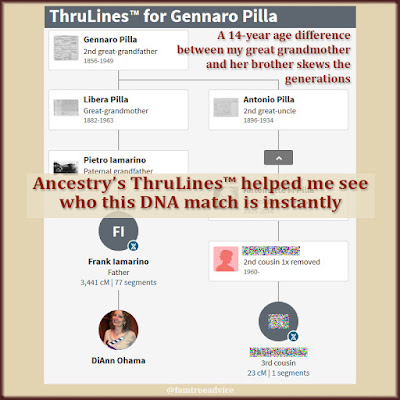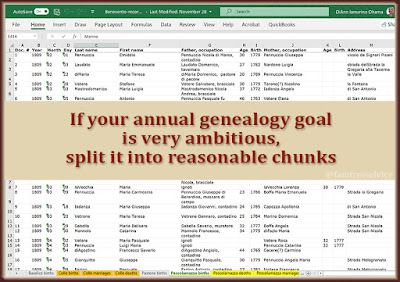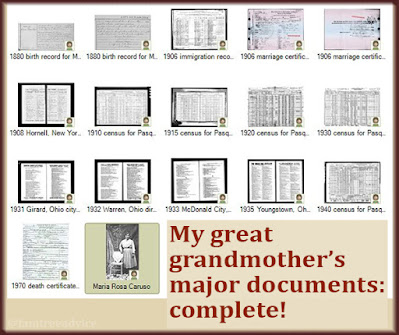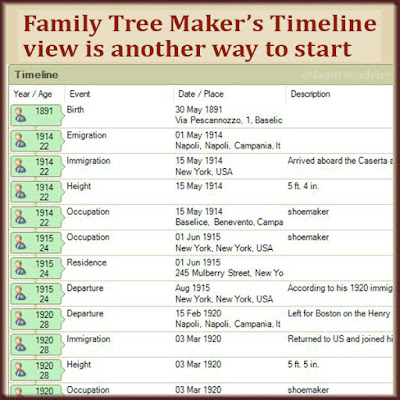I received an Ancestry email for my dad's DNA test account. It says he has a new 2nd cousin once removed that he can find using ThruLines™. Dad's 2nd cousin once removed would be my 3rd cousin, so I took a look.
This new DNA match is the granddaughter of a cousin I identified some years ago. You see, when my paternal grandfather came to America in 1920, he went to join his uncle Antonio Pilla. Grandpa worked for a baker in Newton, a suburb of Boston. But he didn't stay long.
I researched Uncle Antonio's wife and kids in Newton found a living daughter. I wrote to her, but I didn't hear back. Unfortunately, she died in 2014. This new DNA match is her granddaughter.
 |
| Ancestry's ThruLines™ takes the guesswork out of your DNA match's identity. |
Pay It Forward
I've got a ton of Uncle Antonio's ancestors in my family tree, but not for his wife Angelina Iarossi.
I thought it'd be good to build Angelina's branch as much as I can, and then reach out to my newfound 3rd cousin. What if she has photos of Uncle Antonio? If I offer her a ton of info on her grandmother's parents, she may be more likely to share photos.
To keep my enormous family tree from getting out of control, I made a policy a while ago. When it comes to in-laws, I'll record their facts and the names of their parents. That's it. I don't care about their siblings or their grandparents.
I made this decision after a few people contacted me, wondering why their grandfather was in my tree. I didn't have a great answer, and I didn't plan to investigate them any further. So out they went.
I will make an exception to the rule if a relative asks me to do the work. Two weekends ago I added an in-law's siblings and ancestors because my cousin asked me to.
Now I'm concentrating on my DNA 3rd cousin's great grandmother, Angelina Iarossi. She came to America at the age of 2 with her mother. The ship manifest says they came from Castelvetere in Val Fortore, Italy. That's a bit north of the 2 towns where my grandfathers were born.
I'm eager to climb Angelina Iarossi's tree and see what I can find. I know her last name exists in my maternal grandfather's hometown of Baselice. Is there any chance Angelina had roots there and a blood connection to me?
Researching their Family as an Incentive
My first choice for Italian genealogy research is the Antenati website. This government-run site offers free access to countless birth, marriage, and death records. Luckily, they have records for the town of Castelvetere in Val Fortore.
Her naturalization papers say Angelina was born on 6 February 1901. So I went straight to her birth record. It confirms that her parents were Pietro Iarossi and Maria Iarossi. They had the same last name.
 |
| A few quick document searches helped me climb my great uncle's wife's family tree. |
I love it when a birth record includes one of the parent's father's name. Angelina's 1901 birth record told me that:
- Her paternal grandfather was Antonio Iarossi
- Her maternal grandfather was Costanzo Iarossi
I searched the indexes of several years (1872–1882) for the birth records of Pietro and Maria Iarossi. I found Maria Iarossi's 1879 birth record. It confirms her father's name of Costanzo, and adds her mother's name. She was Angela Maria Lupo, the daughter of Nicolangelo Lupo.
Could I climb another generation? I found an 1847 birth record for Costanzo Iarossi. I checked several surrounding years to make sure I didn't have the wrong Costanzo. His parents were Giovanni Iarossi and Catarine Forte.
I got that far while drinking my morning coffee. I'd like to get 3 or 4 solid generations of Angelina's ancestors. Then I'll contact my 3rd cousin DNA match. Her family tree on Ancestry is very small, so these findings may totally blow her away.
We all complain about DNA matches not answering us. But are we doing our best to attract them? You've got to put out the bait to score the information you want.



















